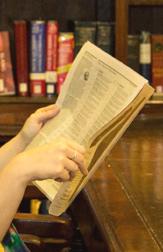Exhibition, Free and Open to the Public: From the Western Front and Beyond: The Writings of World War One
The 100th anniversary of World War One is the focus of the New York Society Library's 2014 exhibition.
WHAT: Commemorative exhibition, From the Western Front and Beyond: The Writings of World War One, features Library’s historic collection, including publications from soldiers, civilians, iconic authors, and Britain’s secret war propaganda machine
WHEN: January 30-November 15, 2014. The New York Society Library is open seven days a week September-May: M/W/F/S 9-5, T/Th 9-7, Su 1-5. June-August, open weekdays only: M/W/F 9-5, T/Th 9-7.
WHERE: The New York Society Library, The Peluso Family Exhibition Gallery, 53 East 79th Street (just east of Madison Avenue; 6 train to 77th Street)
To mark the 100th anniversary of World War One, the New York Society Library presents an exhibition of select literary works and materials from its extensive open stack and rare book collections about the Great War. Titled From the Western Front and Beyond: The Writings of World War One, the exhibition commemorates the war’s unprecedented and extraordinary literary output—including memoirs, fiction, poetry, and propaganda—published during the four years of bloodshed that left millions of people dead and millions more wounded. The exhibition focuses on the Library’s little-known but wide-ranging collection of books written between 1914 and 1918, most of which were acquired during the war and are still in circulation today. Free and open to the public, the exhibition will be on display through November 15, 2014 in the Library’s Peluso Family Exhibition Gallery on East 79th Street.
Founded in 1754, the New York Society Library is the city’s oldest library and one of the nation’s first guardians of literary culture. The institution’s fifteenth Head Librarian Frank Bigelow, who served from 1895 to 1937, began acquiring the remarkable Great War collection in 1914. His initial list included 102 titles. As the war progressed, the tone shifted from government-sanctioned accounts of romanticized valor to un-sanitized reports of the conflict’s horrors. Bigelow’s acquisitions documented the transformation of ordinary soldiers into writers and professional writers into war correspondents. The resulting impressive collection is housed in the Library’s Upper East Side building today.The collection reflects a broad range of writers, from ordinary soldiers, bereaved parents, and unintentional witnesses to those who later became literary icons (including Sir Arthur Conan Doyle, Rudyard Kipling, H.G. Wells, and George Bernard Shaw). As the war stretched on, from months into years, and the number of casualties rose into the millions, it became clear that the traditional ways of writing about war were no longer sufficient. According to exhibition curator Harriet Shapiro, people who had never before written poetry or prose—or had even considered writing—found themselves unable to express the horrors in any other way.
Adding to Shapiro’s perspective, current Head Librarian Mark Bartlett states that war has been a part of the New York Society Library’s institutional memory from its very beginning. “The Library has been a witness to society’s battles dating back to the Revolutionary War when British soldiers stole books to barter for grog and to use as musket fodder, and through the Civil War, when members followed the war news in the reading room,” he said. “World War One, however, was the first war in history to inspire such an unprecedented amount of writing, and the Library felt the need to share the accounts with its members, as well as preserve them for posterity. We’re profoundly moved that we can display this remarkable collection 100 years later, to commemorate the legacy that sprang from the trenches and bloodstained battlefields of the Great War.”Drawing on this remarkable collection, the exhibition includes early editions of the legendary poets Rupert Brooke, Isaac Rosenberg, Wilfred Owen, Robert Graves, and Siegfried Sassoon, and lesser-known accounts by Allied and German soldiers, ambulance drivers, stretcher bearers, nurses, priests, reporters, and artists. Also on display are drawings by Muirhead Bone, an English artist who captured scenes of the towns and battlefields of France.
A softcover catalog accompanies the exhibition. It features contributions from authors Caroline Alexander (The War That Killed Achilles) and Adam Kirsch (Why Trilling Matters) about the war itself and its major writers.“The victims’ words tumbled out into the world as a result of the unthinkable reality that they were witnessing,” explained Harriet Shapiro, who traveled last year to France to tour battlefields as part of her extensive research. “Open any of their memoirs, recite any of their poems or read their letters, and you are transported to the war. Through this exhibition, we hear their stories again. We pay homage to the victims of World War One not with stone monuments, but in the quiet of our Library, with printed words that enable readers to absorb the voices of the war.”
For more information about the exhibition and the Library’s World War One books, click here.
About The New York Society Library
The New York Society Library, the oldest in the city, was founded in 1754 by a civic-minded group formed in the belief that the availability of books would help the city prosper. A subscription library, it now contains more than 300,000 volumes, reflecting the reading and scholarly interests of its members over the last 260 years.

